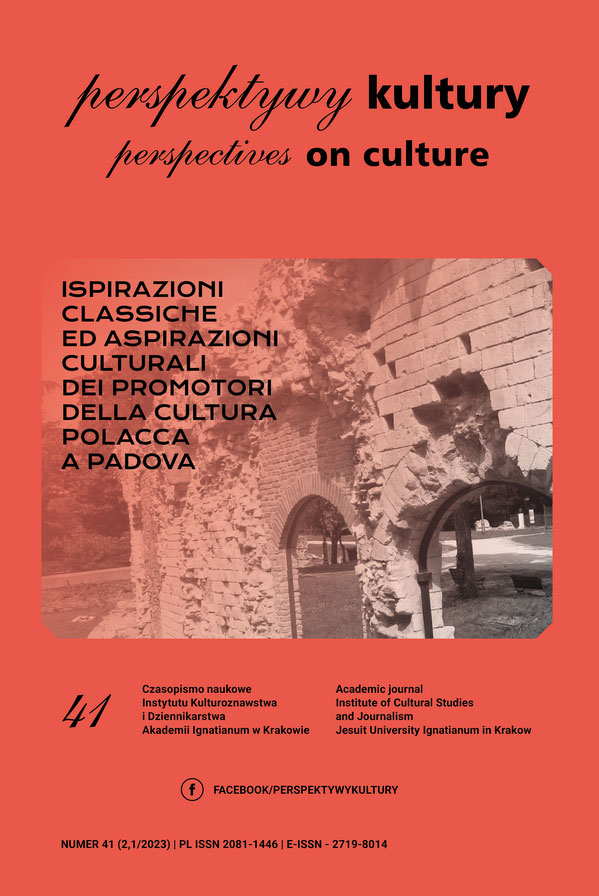The Pilgrim’s Identity in Liquid Modernity
Abstrakt
Droga, podróż, wędrówka to tematy znane z utworów różnych epok historycznych; nadal pojawiają w naukach społecznych, filozofii i literaturze. Zdaniem Zygmunta Baumana jako ludzie przeszliśmy z czasów solidnej nowoczesności, kiedy postrzegaliśmy siebie jako „pielgrzymów” charakteryzowanych pojęciem tożsamości, do czasów płynnej nowoczesności, kiedy jesteśmy „turystami” poszukującymi różnorodnych, ale ulotnych doświadczeń. W niniejszym artykule pokazuję, że idea pielgrzymowania jest nadal aktualna i umożliwia nam wzmocnienie własnej tożsamości. Odwołuję się do szerokiego rozumienia pielgrzymowania w tradycji chrześcijańskiej, do aktualnie obserwowanego wzrostu popularności pielgrzymowania oraz przede wszystkim do interpretacji własnych doświadczeń z odbycia pielgrzymek na hiszpańskich szlakach Camino de Santiago. Na koniec charakteryzuję specyfikę roli pielgrzyma i kryteria kształtowania się jego tożsamości.
Bibliografia
Augustine, A. (2014). The City of God, ed. M. Dodds, Vol. II, Book 19, Ch. 17, https://www.gutenberg.org/ebooks/45305.
Barton, T.G. (ed.) (2020). A Pilgrim’s Testament: The Memoirs of Saint Ignatius of Loyola – New Edition. Brighton, MA: Institute of Jesuit So-urces.
Bauman, Z. (1995). Life in Fragments: Essays in Postmodern Morality. Oxford: Blackwell.
Bauman, Z. (1996). From pilgrim to tourist – or a short history of identity. In: S. Hall, P. Du Gay (eds.), Questions of cultural identity. Sage Publi-cations, Inc., 18–36.
Bauman, Z. (1997). Postmodernity and its Discontents. Cambridge: Polity.
Bauman, Z. (2000). Liquid Modernity. Cambridge/UK: Polity Press.
Benedict (St). (2018). The Holy Rule of St. Benedict. Retrieved from: https://www.ccel.org/ccel/b/benedict/rule/cache/rule.pdf
Bibles, English Standard Version (ESV) Bibles. Retrieved from: https://www.biblestudytools.com/esv/.
Bremer, J. (2007). Santiago de Compostela. Pielgrzymim krokiem. Kra-ków: Wydawnictwo WAM, (subsequent editions) [English title: San-tiago de Compostela. With a pilgrim step].
Bremer, J. (2011). Przyczyny późnośredniowiecznego schyłku pielgrzy-mowania na przykładzie Santiago de Compostela. Folia Turistica, 24, 2011, 163–178 [English title: Reasons for the late medieval pilgrimage on the example of Santiago de Compostela].
Bremer, J. (2012). Camino de Santiago – droga świętych legend. Folia Turistica, nr 27, 93–108, http://www.folia-turistica.pl/attachments/article/402/FT_27_2012.pdf [English title: Camino De Santiago – the Trail of Saintly Legends].
Bremer, J. (2014a). Osoba – fikcja czy rzeczywistość? Tożsamość i jedność Ja w świetle badań neurologicznych. 2-nd edition. Kraków: Aureus [English title: Person – Fiction or Reality? The Identity and Unity of the “Self” in the Light of Neurological Research].
Bremer, J. (2014b). Rene Descartes: Dancing and Mustering Substances. Rocznik Filozoficzny Ignatianum, t. 20, z. 1, 7–26. Retrieved from: https://czasopisma.ignatianum.edu.pl/rfi/article/view/28/pdf.
Bremer, J. (2017). Wittgenstein’s Remarks Concerning the Accessibility of Foreign Cultures. Wittgenstein Studien, t. 8, z. 1, 159–184.
Bremer, J. (2018a). Vierzehnheiligen: Bazylika Czternastu Świętych Wspomożycieli. In: T. Dola, E. Mateja (eds.), Imago – Vox Demon-strans. Studia z dziejów sztuki i kultury. Opole: Redakcja Wydawnictw Wydziału Teologicznego Uniwersytetu Opolskiego, 47–63 [English title: Vierzehnheiligen: Basilica of the Fourteen Holy Helpers].
Bremer, J. (2018b). Johna Bunyana „Wędrówka pielgrzyma” jako alegoria życia chrześcijańskiego. In: Ł. Burkiewicz, R. Hryszko, W. Mruk, P. Wrobel (eds.), Polonia – Italia – Mediterraneum. Studia ofiarowane Pani Profesor Danucie Quirini-Popławskiej. Kraków: Towarzystwo Wy-dawnicze “Historia Iagellonica”, 529–544 [English title: John Bunyan’s Pilgrim’s Progress as an allegory of Christian life].
Brito-Martins, M. (2004). The Concept of peregrinatio in Saint Augustine and its Influences. In: L.Napran, E. van Houts, Exile in the Middle Ages. Turnhout: Brepols Publishers.
Hamblet, W. (2003). Identity, Self-Alienation, and the Problem of Home-lessness. Symposium, Vol. 7, Issue 2, 133–142, https://doi.org/10.5840/symposium20037211.
Harris, M.B. (2019) The Physiological Effects of Walking Pilgrimage. In-ternational Journal of Religious Tourism and Pilgrimage. Vol. 7: Iss. 1, 85–94. Article 9, https://doi.org/10.21427/q6de-av43. Available at: https://arrow.tudublin.ie/ijrtp/vol7/iss1/9.
Hildebrandt-Stramann, R. (2010). Welterschließung durch elementare Bewegungserfahrung. Motorik, 33 (4), 160–166.
Hill-Smith, C. (2011). Cyberpilgrimage: The (Virtual) Reality of Online Pil-grimage Experience. Religion Compass, 5/6, 236–246, 10.1111/j.1749 -8171.2011.00277.x.
Jamieson, Ch. (2019). Pilgrimage, Existence, and Psychic Distress: An Exploration of the Bodily and Psychic Phenomenon of Pilgrimage. In-ternational Journal of Religious Tourism and Pilgrimage, 7(1), 77–84. Retrieved from: http://arrow.dit.ie/ijrtp/.
Kahneman, D., Tversky, A. (1982). The psychology of preferences. Scienti-fic American, 246(1), 160–173.
Lashchuk, I. (2020). Człowiek w drodze. Czytając Zygmunta Baumana. Studia Polsko-Ukraińskie, 7, 233–250 [English title: The Human on the Road. Reading Zygmunt Bauman].
Lienau, D. (2009). Sich erlaufen. Pilgern als Identitätsstärkung. Interna-tional Journal of Practical Theology, 12, Nr. 2, 62–89. Retrieved from: https://onlineperegrino.files.wordpress.com/2015/02/sich-erlaufen-pilgern-als-identitc3a4tsstc3a4rkung-ijpt-2009-5.pdf
Loyola, I (St) (2019). The Spiritual Exercises. Retrieved from: https://www.documentacatholicaomnia.eu/03d/1491-1556,_Ignatius_Loyola, _Spiritual_Exercises,_EN.pdf
Macpherson, H. (2016). Walking methods in landscape research: moving bodies, spaces of disclosure and rapport. Landscape Research, 41:4, 425–432, https://doi.org/10.1080/01426397.2016.1156065.
Nickerson, R.C. Greenia, G.D., McIntosh, I.S. Moore-Quinn, E. (2017). What is Pilgrimage? A Report of the Panel at the 2017 Symposium on Pilgrimage Studies, William & Mary, October 7, 2017; International Journal of Religious Tourism and Pilgrimage, Vol. 6 (ii), 1–6. Retrieved from: https://arrow.dit.ie/ijrtp/vol6/iss2/2].
Nouch, M., Bradley, C. (2019). Green Pilgrimage Lessons Learned for Sustainable Economic Growth A Study of the Grep. In: M. Nouch, C. Bradley, K. Downs, Area of Outstanding Natural Beauty and Kent County Council (report).
Parry, D. (2019). The Form of Prayer and the Spirit of Prayer: George Herbert and John Bunyan in Conversation. The Glass, 19–27.
Petroman, C. et al. (2015). Types of Christian Tourism. Scientific Papers: Animal Science and Biotechnologies, 48(2), 203–206.
Solnit, R. (2001). Wanderlust: A History of Walking. New York: Viking.
Turner, V. (1969). The Ritual Process: Structure and Anti-Structure. Itha-ca: Cornell University Press, 94–130.
Copyright (c) 2023 Akademia Ignatianum w Krakowie

Utwór dostępny jest na licencji Creative Commons Uznanie autorstwa 4.0 Międzynarodowe.
Autor, zgłaszając swój artykuł, wyraża zgodę na korzystanie przez Wydawnictwo Uniwersystet Ignatianum z utworu na następujących polach eksploatacji:
- utrwalania utworu w formie papierowej, a także na nośniku cyfrowym lub magnetycznym;
- zwielokrotnienia utworu dowolną techniką, bez ograniczenia ilości wydań i liczby egzemplarzy;
- rozpowszechniania utworu i jego zwielokrotnionych egzemplarzy na jakimkolwiek nośniku, w tym wprowadzenia do obrotu, sprzedaży, użyczenia, najmu;
- wprowadzenia utworu do pamięci komputera;
- rozpowszechniania utworu w sieciach informatycznych, w tym w sieci Internet;
- publicznego wykonania, wystawienia, wyświetlenia, odtworzenia oraz nadawania i reemitowania, a także publicznego udostępniania utworu w taki sposób, aby każdy mógł mieć do niego dostęp w miejscu i czasie przez siebie wybranym.
Wydawca zobowiązuje się szanować osobiste prawa autorskie do utworu.





